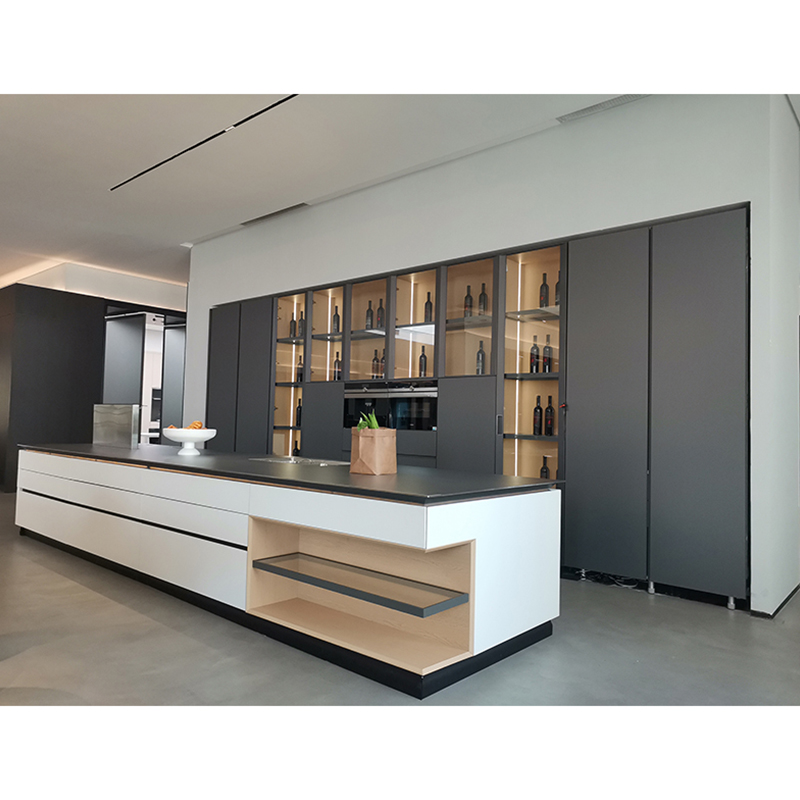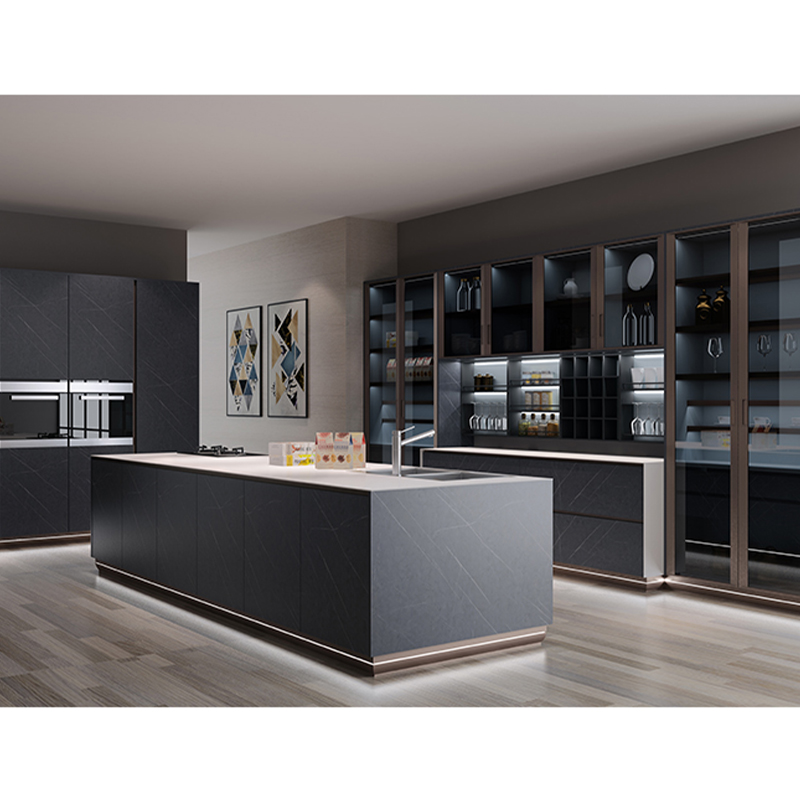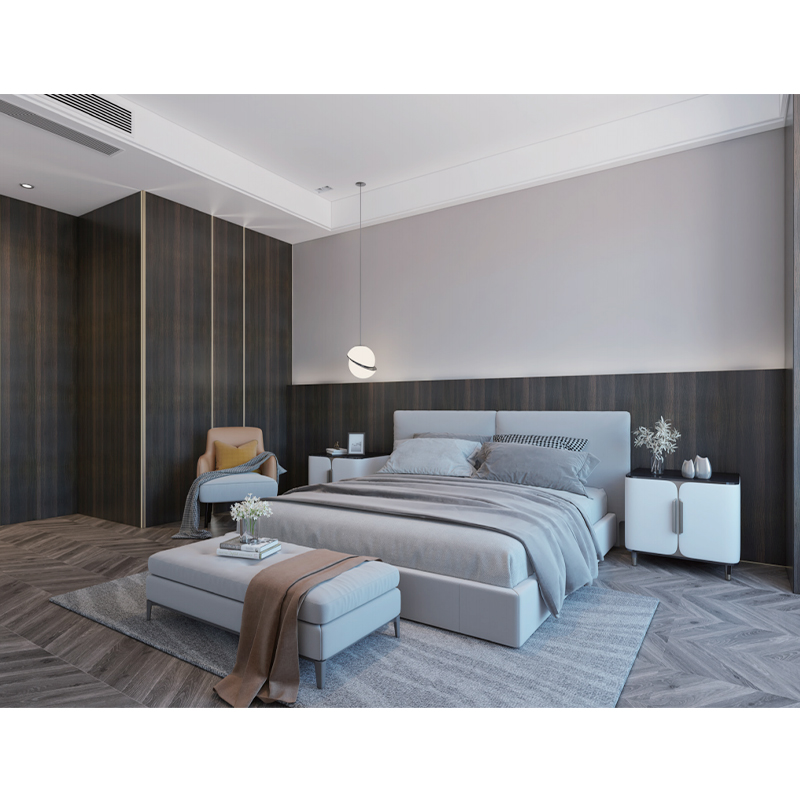How do flat-edge double sided glass interior doors promote even distribution of natural light while ensuring privacy?
Release Time : 2025-09-04
In contemporary interior design, spatial openness, utilization of natural light, and visual continuity have become crucial criteria for living quality. As an innovative design that blends modern aesthetics with practical functionality, flat edge double sided glass interior doors are increasingly popular in residential, commercial, and office spaces. Not only do their minimalist lines and transparent materials elevate the space's style, but they also strike a delicate balance between privacy and natural light, making them an indispensable design element in modern living environments.
1. Double-Sided Glass Structure: Enabling Visual Connectivity and Light Penetration
The core advantage of flat-edge double-sided glass interior doors lies in their use of glass panels on both sides, secured by a high-strength, narrow aluminum alloy frame. This design eliminates the light-blocking effects of traditional solid doors, allowing natural light from windows or primary light sources to freely penetrate multiple rooms. For example, installing this type of door between a living room and study, a bedroom and dressing room, or an office and conference room allows for continuous light flow even when the door is closed, eliminating the awkward "darkness" issue of closing the door. This continuous light transmission effectively increases overall indoor brightness, reduces reliance on artificial lighting, and creates a bright and airy living atmosphere while saving energy.
2. Glass Type Selection: Precisely Regulating the Balance Between Privacy and Light Transmission
While ensuring daylight, privacy is a crucial functional requirement for interior doors. Flat-edge double-paned glass doors offer a precise balance between transparency and privacy by flexibly selecting different glass types. For example, clear glass is suitable for spaces requiring a fully open visual connection, such as a partition between an open kitchen and dining room. Frosted, sandblasted, stained, or patterned glass, by diffusely reflecting light, maintains high light transmittance while obscuring vision and effectively protecting privacy. This type of translucent glass evenly diffuses soft natural light into adjacent areas, preventing glare from direct sunlight while preventing others from clearly observing activities within, perfectly balancing functionality and aesthetics.
3. Flat-Edge Aluminum Frame Design: Maximizes Glass Area and Improves Light Utilization
Unlike traditional glass doors with thick frames or curved edging, flat-edge double-paned glass doors utilize an extremely narrow, flat aluminum alloy frame. This "flat-edge" design not only creates a clean, modern look, but more importantly, it minimizes metal frame obstruction to vision and light, allowing the glass panel to occupy a higher percentage of the room. The larger glass area allows more light to penetrate deeper into the room, especially in corridors, inner rooms, or bathrooms with limited daylight. This design significantly improves brightness and creates a spacious, less oppressive visual experience.
4. Promotes Even Light Distribution and Optimizes Spatial Quality
Natural light, after multiple reflections and scattering, creates a soft, even illumination effect in a room. Acting as a light medium, flat-edge double-paned glass doors allow sunlight to flow between rooms, reducing areas of sharp contrast between light and dark, and avoiding the "light and shadow fragmentation" caused by traditional partitions. For example, when sunlight hits the living room's glass door, some of the light is refracted into the adjacent study or entryway, bathing these areas in natural light. This even light distribution not only enhances the comfort of the space but also enhances the texture of the materials—the grain of the wood, the texture of the wall, and the outlines of the furniture become more vivid and three-dimensional under natural light.
5. Suitable for Various Spaces, Achieving a Balance of Function and Aesthetics
Whether used as a bedroom partition or a dressing room door in a residence, a conference room door in an office, or a display area partition in a commercial space, flat edge double sided glass doors can be customized to meet specific needs. By adjusting the glass transmittance and aluminum frame color, the door can seamlessly blend into the overall decor. Its durable aluminum structure ensures long-term deformation resistance, while the symmetrical design of the double-sided glass creates a consistent aesthetic from any angle, further enhancing the space's cohesiveness and sense of luxury.
In summary, through a strategic combination of materials and sophisticated design, flat-edge double-sided glass interior doors significantly promote the even distribution of natural light throughout the room while ensuring necessary privacy. It is not only a functional partition, but also a "light medium" that connects spaces, guides light, and improves quality, injecting transparency, brightness and elegance into modern living spaces.
1. Double-Sided Glass Structure: Enabling Visual Connectivity and Light Penetration
The core advantage of flat-edge double-sided glass interior doors lies in their use of glass panels on both sides, secured by a high-strength, narrow aluminum alloy frame. This design eliminates the light-blocking effects of traditional solid doors, allowing natural light from windows or primary light sources to freely penetrate multiple rooms. For example, installing this type of door between a living room and study, a bedroom and dressing room, or an office and conference room allows for continuous light flow even when the door is closed, eliminating the awkward "darkness" issue of closing the door. This continuous light transmission effectively increases overall indoor brightness, reduces reliance on artificial lighting, and creates a bright and airy living atmosphere while saving energy.
2. Glass Type Selection: Precisely Regulating the Balance Between Privacy and Light Transmission
While ensuring daylight, privacy is a crucial functional requirement for interior doors. Flat-edge double-paned glass doors offer a precise balance between transparency and privacy by flexibly selecting different glass types. For example, clear glass is suitable for spaces requiring a fully open visual connection, such as a partition between an open kitchen and dining room. Frosted, sandblasted, stained, or patterned glass, by diffusely reflecting light, maintains high light transmittance while obscuring vision and effectively protecting privacy. This type of translucent glass evenly diffuses soft natural light into adjacent areas, preventing glare from direct sunlight while preventing others from clearly observing activities within, perfectly balancing functionality and aesthetics.
3. Flat-Edge Aluminum Frame Design: Maximizes Glass Area and Improves Light Utilization
Unlike traditional glass doors with thick frames or curved edging, flat-edge double-paned glass doors utilize an extremely narrow, flat aluminum alloy frame. This "flat-edge" design not only creates a clean, modern look, but more importantly, it minimizes metal frame obstruction to vision and light, allowing the glass panel to occupy a higher percentage of the room. The larger glass area allows more light to penetrate deeper into the room, especially in corridors, inner rooms, or bathrooms with limited daylight. This design significantly improves brightness and creates a spacious, less oppressive visual experience.
4. Promotes Even Light Distribution and Optimizes Spatial Quality
Natural light, after multiple reflections and scattering, creates a soft, even illumination effect in a room. Acting as a light medium, flat-edge double-paned glass doors allow sunlight to flow between rooms, reducing areas of sharp contrast between light and dark, and avoiding the "light and shadow fragmentation" caused by traditional partitions. For example, when sunlight hits the living room's glass door, some of the light is refracted into the adjacent study or entryway, bathing these areas in natural light. This even light distribution not only enhances the comfort of the space but also enhances the texture of the materials—the grain of the wood, the texture of the wall, and the outlines of the furniture become more vivid and three-dimensional under natural light.
5. Suitable for Various Spaces, Achieving a Balance of Function and Aesthetics
Whether used as a bedroom partition or a dressing room door in a residence, a conference room door in an office, or a display area partition in a commercial space, flat edge double sided glass doors can be customized to meet specific needs. By adjusting the glass transmittance and aluminum frame color, the door can seamlessly blend into the overall decor. Its durable aluminum structure ensures long-term deformation resistance, while the symmetrical design of the double-sided glass creates a consistent aesthetic from any angle, further enhancing the space's cohesiveness and sense of luxury.
In summary, through a strategic combination of materials and sophisticated design, flat-edge double-sided glass interior doors significantly promote the even distribution of natural light throughout the room while ensuring necessary privacy. It is not only a functional partition, but also a "light medium" that connects spaces, guides light, and improves quality, injecting transparency, brightness and elegance into modern living spaces.







